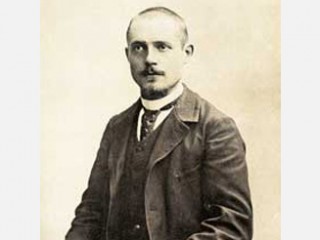
Charles Péguy biography
Date of birth : 1873-08-07
Date of death : 1914-09-05
Birthplace : Orléans, France
Nationality : French
Category : Arts and Entertainment
Last modified : 2011-02-03
Credited as : Poet and author, essayist,
The French poet and author Charles Pierre Péguy was a fervent Roman Catholic, patriot, and social reformer. Through his writings and actions he influenced many Frenchmen who went to war in 1914.
Born into a working-class family in Orléans on Aug. 7, 1873, Charles Péguy was able, thanks to scholarships, to attend Lakanal, the celebrated lycée outside Paris, and the école Normale Supérieure in Paris, another celebrated academic institution. At the école Normale he studied under Henri Bergson, whose antirationalistic philosophy did much to confirm Péguy's mystic bent. Although Péguy wished to become a teacher, he failed the agrégation examination and then became a writer. His first work, Jeanne d'Arc, Domrémy, les Batailles, written in collaboration with Marcel Baudouin, revealed Péguy's socialist orientation and his Christian inspiration, both of which grew deeper. Jeanne d'Arc is a "drama dedicated to all who will have died fighting against universal evil, to all who will have died to found the universal socialist Republic." It appeared in 1897. Three years later Péguy founded the periodical Cahiers de la quinzaine as a means of communicating his ideas directly. He then concentrated his energies on polemical writing until, a few years before his death, he began working on the great liturgical poems for which he is now famous.
Péguy's ideological views are strong and stern; yet, at least when observed from a distance and en bloc, they appear more than a little contradictory. Péguy was a militant defender of Capt. Alfred Dreyfus but not an enemy of the army; he could not accept all the teachings of the Church, yet he was profoundly Christian; he was a Socialist and at the same time a severe critic of the Socialist party. Some of the contradictions, however, disappear when his thought is placed in its historical context and its fluctuations and evolution are traced. When a student at Lakanal, Péguy moved toward socialism in proportion as he moved away from the Church. Then, when a student at the école Normale, although his fervor for socialism had in no way abated, he moved closer to the Church. By a curious but not illogical itinerary, Péguy went from a defense of social causes like Dreyfusism to a defense of army and nation, whose honor he vindicated by refusing all conformism and whitewash. From the nation he moved to a defense of the Church—Joan of Arc is a double heroine. Yet not until 1908 did Péguy declare openly that he had found his faith again. And still there were reserves and recantations; his Christianity was never quite orthodox, just as his socialism was always highly individualistic. From 1900 Péguy declared his objections to the Socialist party openly. He deplored socialism's identification with materialism and atheism as well as its tacit approval of conformism and collectivism. When the Tangier incident brought home to him the danger that threatened France, socialism with its internationalism and pacifism finally had nothing more to say to Péguy. For the rest of his life he campaigned for Church and country.
A close look at Péguy's ideas in historical context and chronology reveals most clearly that in every instance his stand was dictated by a passion for truth and justice. And this passion gave his thought its basic coherence. It was in the name of truth and justice that he published his Cahiers and, in its pages, did not hesitate to attack any institution—the Church, the university, the Socialist party—that he found guilty of betraying its mission or, as he said, of sacrificing a mystique to a politique. In the name of truth and justice he invited contributions from thinkers of diverse tendencies. Although its circulation was never very large, the Cahiers de la quinzaine thus exercised a significant force in the spiritual and intellectual life of pre-World War I France.
Péguy's conversion in 1908 gave impetus to his creative work. He revised his Jeanne d'Arc and composed the extraordinarily long lyrical meditations that he called mysteres and tapisseries. In Jeanne he had mingled prose and verse. For the mysteres he used free verse with blanks and full stops, which created a very personal rhythm pattern. Le Porche du mystere de la deuxieme virtu (1911) is one of the most famous. For subsequent works Péguy preferred a more orthodox line. The 8,000 verses of Eve (1913), completed a few months before his death, were written in unbroken Alexandrines. But Péguy's phrasing was still the solemn and repetitious sort associated with a litany. Each strophe repeats the preceding one with only minor variation to indicate the slow but sure progress of the poem. Their rhythm has reminded critics of a soldiers's step or of the plodding footfall of a peasant. In structure Péguy's poems constitute vast accumulations of pious rhapsody and reflexion, a verbal cathedral, as it were, raised to the glory of God. Péguy's poetry stands somewhat outside the French traditions, far removed from symbolist or modernist trends.
Charles Péguy enlisted on the first day of World War I and shortly afterward was killed leading his men in a charge in the Battle of the Marne on Sept. 5, 1914.
Julien Green and Ann Green published two volumes of translations of Péguy's works, Basic Verities: Prose and Poetry (1943) and Men and Saints: Prose and Poetry (1944). There are two additional volumes published by Julien Green, God Speaks: Religious Poetry (1945) and The Mystery of the Charity of Joan of Arc (1950). Pansy Pakenham translated The Mystery of the Holy Innocents, and Other Poems (1956). Majorie Villiers, Charles Péguy: A Study in Integrity (1966), is the first full-length biography of Péguy in English.
















